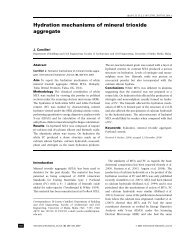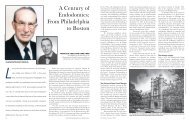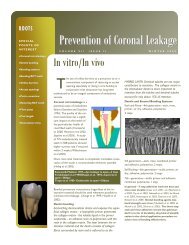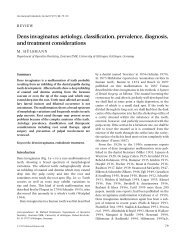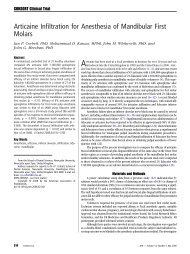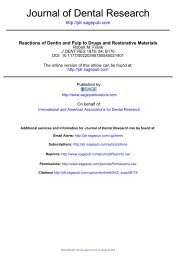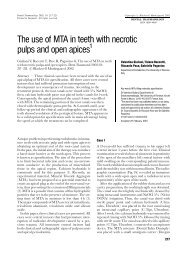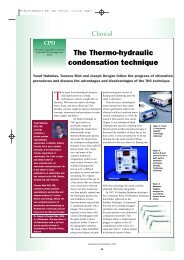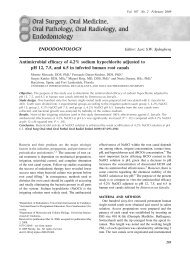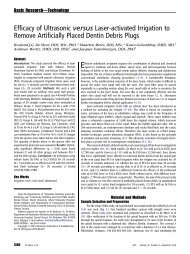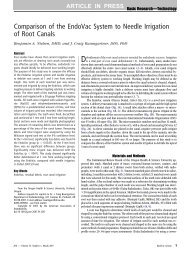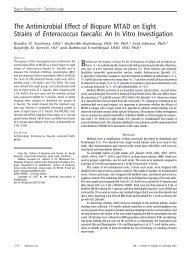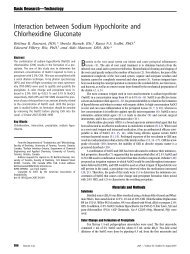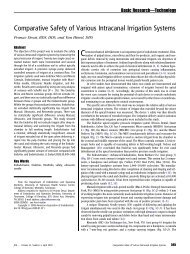Irrigation in Endodontics - The Endoexperience
Irrigation in Endodontics - The Endoexperience
Irrigation in Endodontics - The Endoexperience
You also want an ePaper? Increase the reach of your titles
YUMPU automatically turns print PDFs into web optimized ePapers that Google loves.
308<br />
Haapasalo et al<br />
debridement of anastomoses between double canals, isthmuses, and f<strong>in</strong>s. 78–80 <strong>The</strong><br />
effectiveness of ultrasonics <strong>in</strong> the elim<strong>in</strong>ation of bacteria and dent<strong>in</strong> debris from<br />
the canals has been shown by several studies. 81–85 However, not all studies have<br />
supported these f<strong>in</strong>d<strong>in</strong>gs. 80<br />
Van der Sluis and colleagues 84 suggested that a smooth wire dur<strong>in</strong>g ultrasonic<br />
irrigation is as effective as a size 15 K-file <strong>in</strong> the removal of artificially placed dent<strong>in</strong><br />
debris <strong>in</strong> grooves <strong>in</strong> simulated root canals <strong>in</strong> res<strong>in</strong> blocks. It is possible that preparation<br />
complications are less likely to occur with an ultrasonic tip with a smooth, <strong>in</strong>active<br />
surface.<br />
SUMMARY<br />
<strong>Irrigation</strong> has a key role <strong>in</strong> successful endodontic treatment. Although hypochlorite is<br />
the most important irrigat<strong>in</strong>g solution, no s<strong>in</strong>gle irrigant can accomplish all the tasks<br />
required by irrigation. Detailed understand<strong>in</strong>g of the mode of action of various<br />
solutions is important for optimal irrigation. New developments such as CFD and<br />
mechanical devices will help to advance safe and effective irrigation.<br />
ACKNOWLEDGMENTS<br />
<strong>The</strong> authors would like to thank Ingrid Ellis for her editorial assistance <strong>in</strong> the f<strong>in</strong>al<br />
preparation of this manuscript.<br />
REFERENCES<br />
1. Peters OA, Schönenberger K, Laib A. Effects of four Ni-Ti preparation techniques<br />
on root canal geometry assessed by micro computed tomography. Int Endod J<br />
2001;34:221–30.<br />
2. Hülsmann M, Hahn W. Complications dur<strong>in</strong>g root canal irrigation: literature review<br />
and case reports [review]. Int Endod J 2000;33:186–93.<br />
3. Mcdonnell G, Russell D. Antiseptics and dis<strong>in</strong>fectants: activity, action, and resistance.<br />
Cl<strong>in</strong> Microbiol Rev 1999;12:147–79.<br />
4. Barrette WC Jr, Hannum DM, Wheeler WD, et al. General mechanism for the<br />
bacterial toxicity of hypochlorous acid: abolition of ATP production. Biochemistry<br />
1989;28:9172–8.<br />
5. McKenna SM, Davies KJA. <strong>The</strong> <strong>in</strong>hibition of bacterial growth by hypochlorous<br />
acid. Biochem J 1988;254:685–92.<br />
6. Zehnder M, Kosicki D, Luder H, et al. Tissue-dissolv<strong>in</strong>g capacity and antibacterial<br />
effect of buffered and unbuffered hypochlorite solutions. Oral Surg Oral Med Oral<br />
Pathol Oral Radiol Endod 2002;94:756–62.<br />
7. Gomes BP, Ferraz CC, Vianna ME, et al. In vitro antimicrobial activity of several<br />
concentrations of sodium hypochlorite and chlorhexid<strong>in</strong>e gluconate <strong>in</strong> the elim<strong>in</strong>ation<br />
of Enterococcus faecalis. Int Endod J 2001;34:424–8.<br />
8. Radcliffe CE, Potouridou L, Qureshi R, et al. Antimicrobial activity of vary<strong>in</strong>g<br />
concentrations of sodium hypochlorite on the endodontic microorganisms Act<strong>in</strong>omyces<br />
israelii, A. naeslundii, Candida albicans and Enterococcus faecalis. Int<br />
Endod J 2004;37:438–46.<br />
9. Vianna ME, Gomes BP, Berber VB, et al. In vitro evaluation of the antimicrobial<br />
activity of chlorhexid<strong>in</strong>e and sodium hypochlorite. Oral Surg Oral Med Oral Pathol<br />
Oral Radiol Endod 2004;97:79–84.<br />
10. Waltimo TM, Ørstavik D, Siren EK, et al. In vitro susceptibility of Candida albicans<br />
to four dis<strong>in</strong>fectants and their comb<strong>in</strong>ations. Int Endod J 1999;32:421–9.



